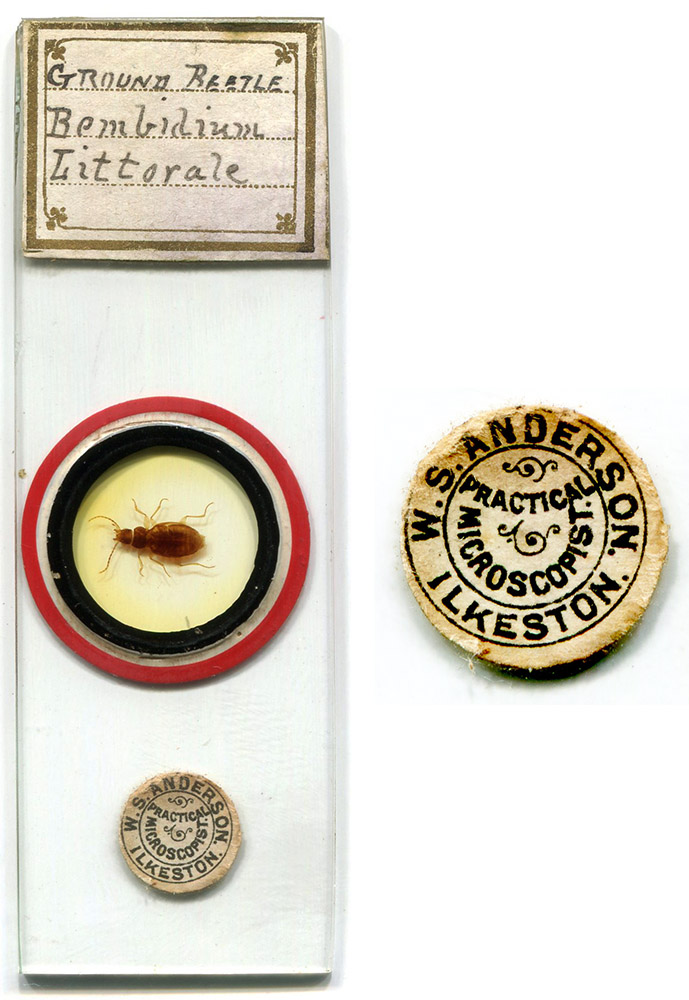
Figure 1. A microscope slide by W.S. Anderson, “Practical Microscopist”. He advertised to sell mounted specimens of the ground beetle (Bembidium littorale) in 1887 (see Figure 4).
William Snowdell/Snowdall Anderson, 1867 - 1948
by Brian Stevenson
last updated June, 2023
W.S. Anderson, “Practical Microscopist”, of Ilkeston, Derbyshire, was a semi-professional English microscope slide-maker, active during the mid 1880s. His mounts are generally well-made, and should be welcome in any collection (Figure 1). In 1887, the Editor of The Journal of Microscopy and Natural Science stated, “We are not sure that we have met with better specimens of whole-insect mounts”.
Anderson’s slides are relatively rare – his work is mentioned, but not illustrated, in Brian Bracegirdle’s Microscopical Mounts and Mounters – probably because Anderson was only in business for 3-4 years. He began advertising that he had “good micro slides” to exchange in 1885, was a full-fledged professional in 1887, but ceased advertising by 1888 (Figures 2-6). Anderson also operated a photography business, but that also ended after 1888. Anderson moved to Australia in 1889.

Figure 1.
A microscope slide by W.S. Anderson, “Practical Microscopist”. He advertised to sell mounted specimens of the ground beetle (Bembidium littorale) in 1887 (see Figure 4).

Figure 2.
1885 exchange offers from “Hardwicke’s Science-Gossip”, 1885, in chronological order. These are the first known indications of W.S. Anderson’s interests in microscopy. The slides that he offered may have been his own preparations, or may have been acquired from other microscopists, but all of the stated specimens would be relatively simple to prepare. His requests for books on the fundamentals of microscopy suggest that he was a relative novice.

Figure 3.
1886 exchange offers from “Hardwicke’s Science-Gossip”, in chronological order, and one exchange offer from “The Scientific Inquirer”. His first request, for a microtome, section knife, and Valentine knife indicate that he wanted to begin preparing thin sections for mounting. His request for whole insects shows further ambitions, as whole insects need to be cleared and flattened before mounting. By the time of “The Scientific Enquirer” exchange advertisement, Anderson was evidently skilled at grinding and mounting thin sections of bone and other hard tissues.
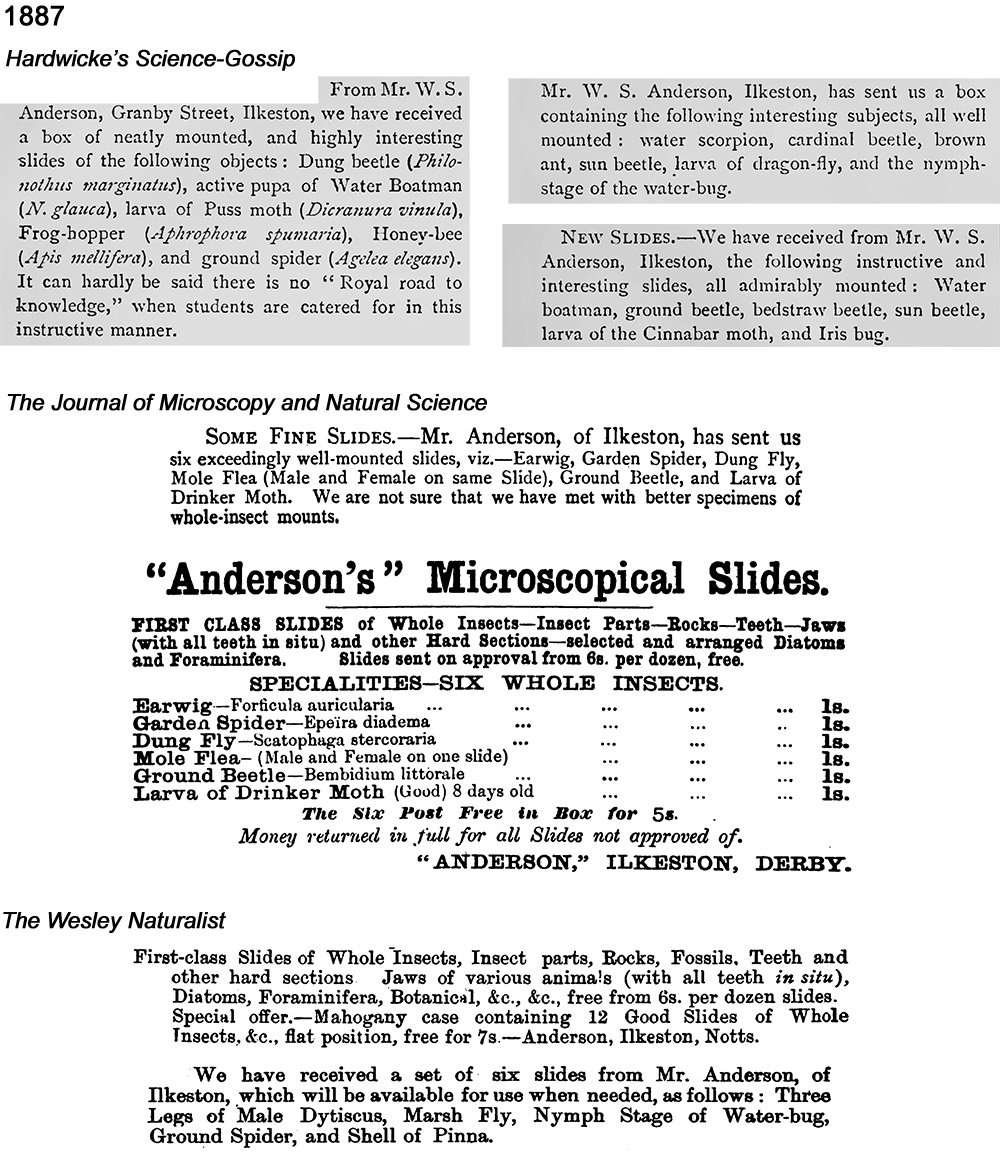
Figure 4.
Anderson’s 1887 entries in popular science magazines indicate that he was then a professional slide-maker. It was common for professionals to send examples of their slides to journal editors, with the hope that they would receive free advertising. Note that Anderson was selling slides of whole ground beetles at this time (see Figures 1 and 8).

Figure 5.
By 1887, W.S. Anderson also had a professional photography studio, although he was in the process of moving when these advertisements were published. The blurb in the lower right is from an advertisement for a photographic paper manufacturer, and indicates that Anderson’s photographic studio was located on Granby Street, Ilkeston, in July, 1888.
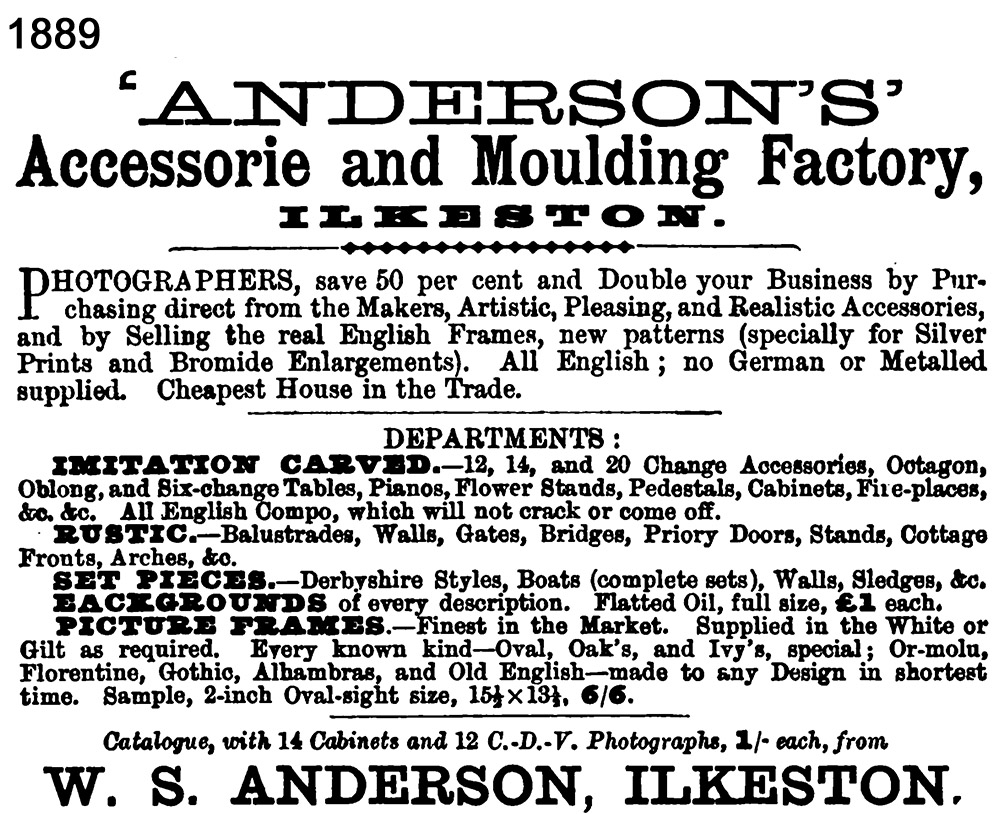
Figure 6.
The last known record of Anderson’s business in England, advertising picture frames and photographers’ props. He may have made some of these items himself.
William Snowdell Anderson was born during the summer of 1867, in Surfleet, Lincolnshire. “Snowdell” (also spelled "Snowdale" or "Snowdall") was the maiden name of his mother, Ann. Father George was a blacksmith. William was the third child, and first son.
The 1881 national census recorded William as a 13 year-old “scholar”, living with his parents in Holbeach, Lincolnshire. One of his elder sisters, 18 year-old Alice, was a “cook, domestic” in the home of the Weatherhog family, at 7 Granby Street, Ilkeston, Derbyshire. The Weatherhog family moved away from Granby Street before the end of the decade.
William likely moved into 7 Granby Street around 1885-86, possibly as servant to the Weatherhog family. Making microscope slides was probably not much of a business for William before 1887, considering that all of his previous advertisements were appeals to exchange for books and equipment. By 1887, Anderson was attempting to make slide-making into a regular business. He certainly impressed editors of popular science magazines, who endorsed his productions (Figure 4).
He also operated a photography studio. He was listed in the 1887 edition of Kelly's Directory. Considering that he was selling off his props in 1887, it was probably not a successful venture.
William Snowdell Anderson departed from London in November, 1889, accompanied by younger sisters Anne and Ethel. They arrived in Melbourne, Australia, in January, 1890.
Bertha Wardle, of Ilkeston, Derbyshire, left England in March 1890, and arrived in Melbourne several weeks later. She and William married soon after her arrival. That short duration suggests that Bertha and William knew each other before coming to Australia. The couple later had two children.
William set himself up as a professional photographer (Figure 7). Around 1903, he purchased a studio in Ormond, Victoria. He died in that town on July 5, 1948.
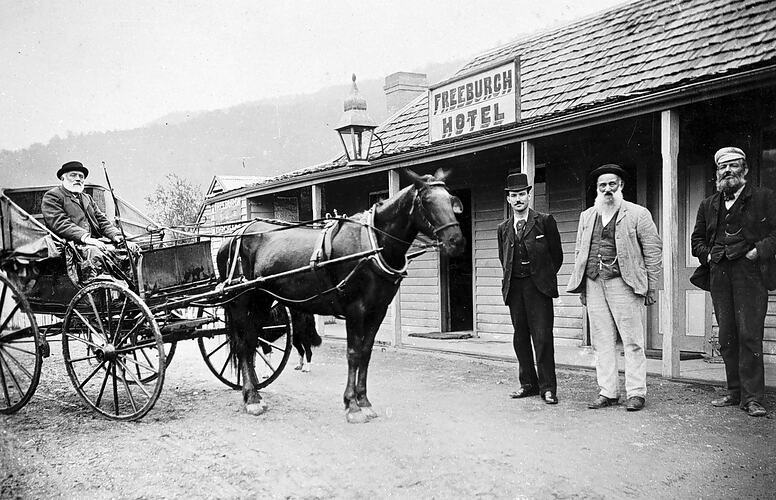
Figure 7.
Circa 1890 photograph by William Snowdell Anderson, in Freeburgh, Victoria, Australia. Adapted for nonprofit, educational purposes from Museums Victoria Collections, https://collections.museumsvictoria.com.au/items/767640
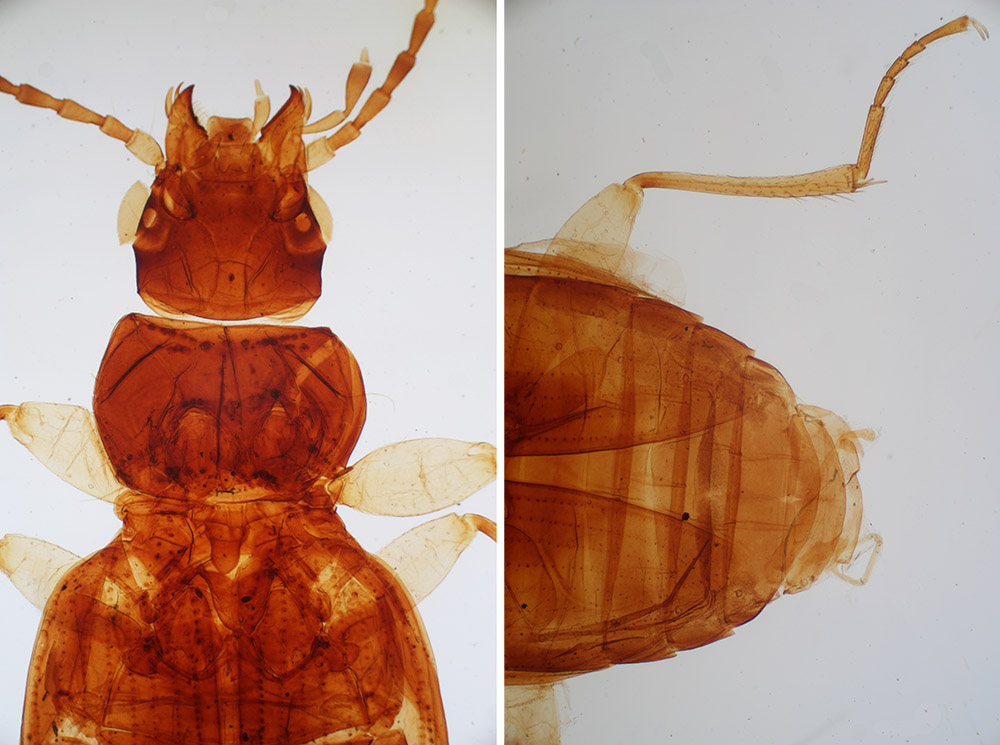
Figure 8.
Photomicrographs of a Bembidium littoral ground beetle, prepared ca. 1887 by W.S. Anderson (see Figure 1). Images were prepared with a 3.5x objective lens, transmitted light, and C-mounted digital SLR camera on a Leitz Ortholux II microscope.
Resources
Adamson, Keith I.P. (1997) Professional Photographers in Derbyshire 1843-1914, Supplement to The PhotoHistorian, Number 118
The Age (Melbourne) (1889) “Messrs. Gibbs, Bright and Co., agents for the Anglo-Australian Steam Navigation Company Limited, report that the s. Port Caroline of that company’s line left London on the 24th inst. With passengers and cargo for Australia, and may be expected to arrive here in the first week of January next”, November 30 issue, page 8
Australia census and other records, accessed through ancestry.com
Australia immigration record of William Snowdell Anderson (1890), accessed through ancestry.com
Bracegirdle, Brian (1998) Microscopical Mounts and Mounters, Quekett Microscopical Club, London, page 3
The British Journal Photographic Almanac (1889) Advertisement from Miss Amy Scott photographic paper, including quote from W.S. Anderson, page 239
British Journal of Photography Annual (1888) Advertisement from W.S. Anderson, page 177
Collections of Museums Victoria (accessed June, 2023) https://collections.museumsvictoria.com.au
England census and other records, accessed through ancestry.com
English emigration record of Bertha Wardle (1890), accessed through ancestry.com
Hardwicke’s Science-Gossip (1884) Nothing from W.S. Anderson, Vol. 20
Hardwicke’s Science-Gossip (1885) Exchange offers from W.S. Anderson, Vol. 21, pages 143, 144, 168, and 284
Hardwicke’s Science-Gossip (1886) Exchange offers from W.S. Anderson, Vol. 22, pages 96, 120, 168, 192, and 284
Hardwicke’s Science-Gossip (1887) Editors notes on slides from W.S. Anderson (no exchange offers from Anderson), Vol. 23, pages 16, 42, and 116
An Index to Derbyshire Photographers & Photographic Studios (accessed June, 2023) https://freepages.rootsweb.com/~brett/genealogy/photos/dbyphoto_index.html
The Journal of Microscopy and Natural Science (1887) Editors note on slides from W.S. Anderson, Vol. 6, page 121
The Journal of Microscopy and Natural Science (1887) Advertisement from W.S. Anderson, Vol. 6, July issue
Marriage record of William Snowdell Anderson and Bertha Wardle (1890), accessed through ancestry.com
Payne, Brett (accessed June, 2023) Sepia Saturday 182: William Snowdall Anderson of Ilkeston and Lorne, http://photo-sleuth.blogspot.com/2013/06/sepia-saturday-182-william-snowdall.html
Photographer's World (1887) Advertisement from W.S. Anderson, December 15 issue, page 195
The Photographic News (1887) Advertisement from W.S. Anderson, Vol. 31, May 27 issue, page iv
The Scientific Inquirer (1886) Exchange offer from W.S. Anderson, Vol. 1, page 100
The Wesley Naturalist (1887) Editors note on slides from W.S. Anderson, Vol. 1, pages 32, 64, and 90